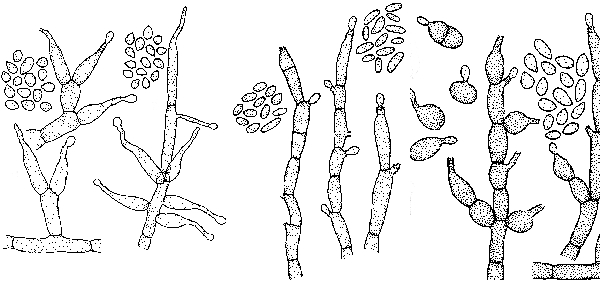Main page <> Index of descriptions <> Previous description <> Exophiala <> Next description
Exophiala

Exophiala species are usually included among the fungi called "black yeasts". Conidia are typically borne at the tips of short annellides produced along the vegetative hyphae. The annellides are often difficult to see and to determine that they actually are annellides. Species of Phialophora are similar but produce their conidia on phialides rather than annellides. Species of Aureobasidium, another genus of black yeasts, produce conidia holoblastically on minute peg-like extensions of short hyphal branches or directly along the hyphae themselves.
Some species of Exophiala are known to cause a subcuaneous disease in humans and other vertebrates. Although not normally life-threatening, these infections must be removed surgically or they may continue to grow for years. In handling these fungi, care must be taken not to accidentally inoculate oneself with contaminated instruments.
The natural habitats of Exophiala species are hard to pin down. They can be isolated from decaying plant material, wood, sewage sludge, soil, tree exudates and many other sources. They sometimes appear in unlikely places, such as in syrup-like solutions of polyvinyl alcohol. They are often most easily found by locating the small perithecia of the Exophiala holomorphs.
Classification: Herpotrichiellaceae (Eurotiomycetes). Holomorph: Capronia. Refs: Hoog and Hermanides-Nijhoff, 1977; Untereiner, et al., 1995. The drawings used here are from the Ph.D. thesis of Wendy Undereiner.